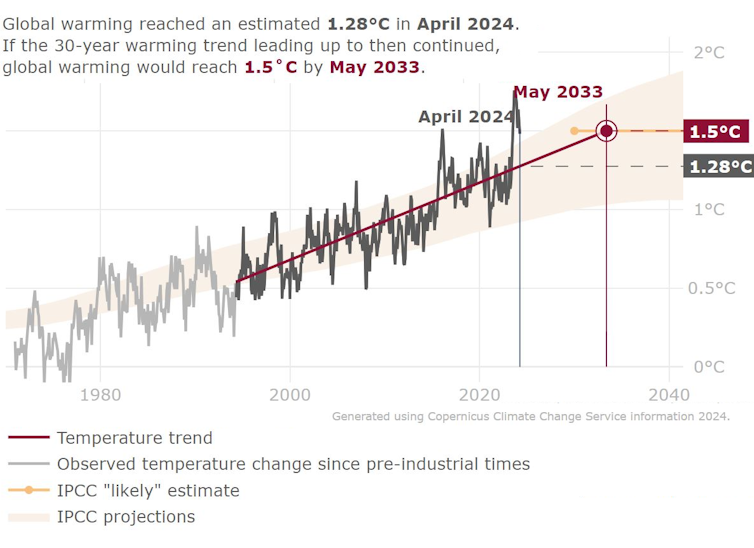Less than a month into summer 2024, extreme heat waves have already swept across the majority of the U.S. population. Millions have faced heat warnings in the western U.S. in early July or struggled with humid heat in the East. On July 7, Death Valley reached a perilous 129 degrees Fahrenheit (53.9 C), a day after a motorcyclist succumbed to heat exposure there. Las Vegas also shattered its all-time heat record at 120 F (48.9 C). In California, over a week of triple-digit temperatures dried out the landscape, leading to wildfires.
The intense heat is not confined to the U.S.; countries worldwide are experiencing record-breaking temperatures in 2024. According to the European Union’s Copernicus climate service, each of the past 13 months has been the hottest on record for that month, with the previous 12 months averaging at least 1.5 C (2.7 F) warmer than the pre-industrial average from 1850-1900. This warming threshold is part of the Paris climate agreement, where countries pledged to limit global warming to under 1.5 C, averaged over a 30-year period to account for natural fluctuations. Though this threshold has been crossed for a single year, it remains a dire indicator that the world may exceed this 30-year average threshold within the next decade.
Globally, 2024 has seen record heat across the Americas, Africa, Europe, and Asia. In Mexico and Central America, persistent heat combined with prolonged drought has led to severe water shortages and numerous deaths. In Saudi Arabia, over 1,000 people died from heat during the Hajj pilgrimage to Mecca, with temperatures reaching 125 F (51.8 C) on June 17. Hospitals in Karachi, Pakistan, have been overwhelmed due to high heat, frequent power outages, and water shortages, while India faced prolonged heatwaves with temperatures around 120 F (48.9 C) affecting millions.
 In Europe, Greece experienced over 100 F (37.8 C) temperatures for days in June, resulting in fatalities among tourists hiking in the extreme heat. Japan issued heatstroke alerts in Tokyo and more than half of its prefectures as temperatures soared to record highs in early July.
In Europe, Greece experienced over 100 F (37.8 C) temperatures for days in June, resulting in fatalities among tourists hiking in the extreme heat. Japan issued heatstroke alerts in Tokyo and more than half of its prefectures as temperatures soared to record highs in early July.
The severity and extent of 2024’s heat waves underscore the impact of human-caused climate change. A scientific assessment of the June 2024 heatwave in the eastern U.S. suggests that such extreme and prolonged heat is now two to four times more likely due to climate change. Over the past several decades, the number of U.S. heat waves has increased rapidly, often occurring outside the peak of summer.
Globally, the climate has warmed more than 2.2 F (1.2 C) above pre-industrial levels, driven by large-scale greenhouse gas emissions. While a small temperature increase might seem negligible, even fractions of a degree have significant impacts on the global climate. During the last ice age, about 20,000 years ago, the Earth was only about 11 F (6 C) cooler than today, indicating how a seemingly small temperature change can have profound effects.
The summer of 2024 is likely to be among the hottest on record, but future summers could be even hotter. Vulnerable populations, including young children, older adults, and outdoor workers, face heightened risks. People in lower-income neighborhoods or those without adequate access to air conditioning will encounter increasingly dangerous conditions. Extreme heat also impacts infrastructure, causing transit delays and overloading electric systems, leading to blackouts during critical periods.
Despite these daunting challenges, there are solutions. While countries are not currently on track to meet their Paris Agreement goals, progress has been made. In the U.S., the 2022 Inflation Reduction Act aims to reduce greenhouse gas emissions by nearly half by 2035. Switching from air conditioners to heat pumps and geothermal systems can reduce fossil fuel emissions and provide cost-effective cooling. The decreasing cost of renewable energy and increasing policy support and incentives are encouraging signs.
Humanity can still limit future warming by taking urgent action to reduce fossil fuel emissions. This can help prevent more severe heat waves and droughts, while also providing benefits such as improved public health, job creation, and reduced risks to ecosystems.